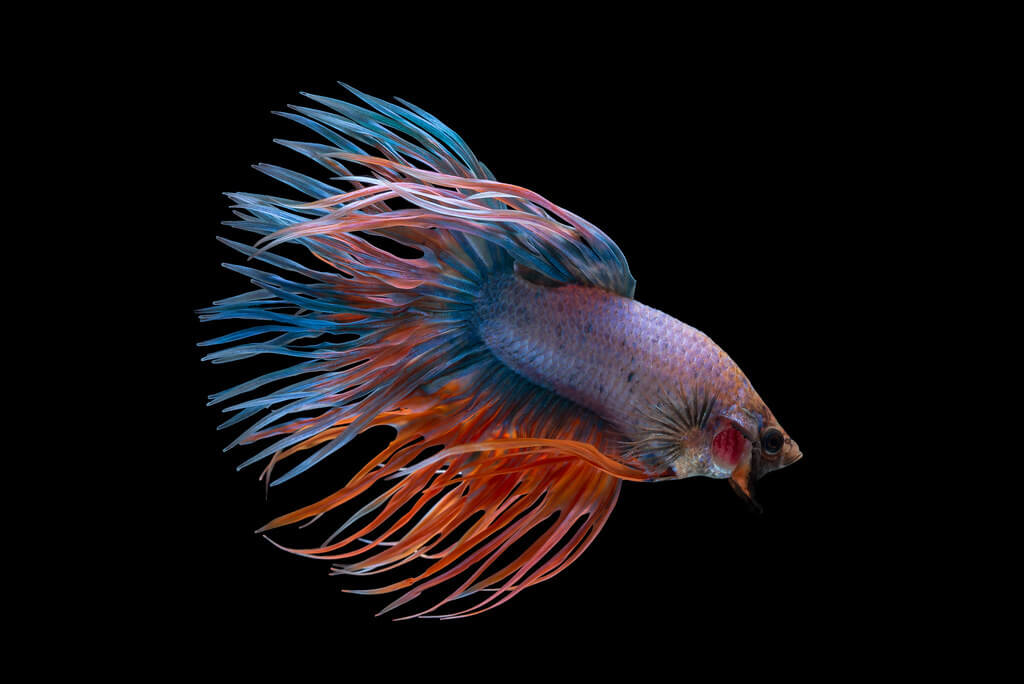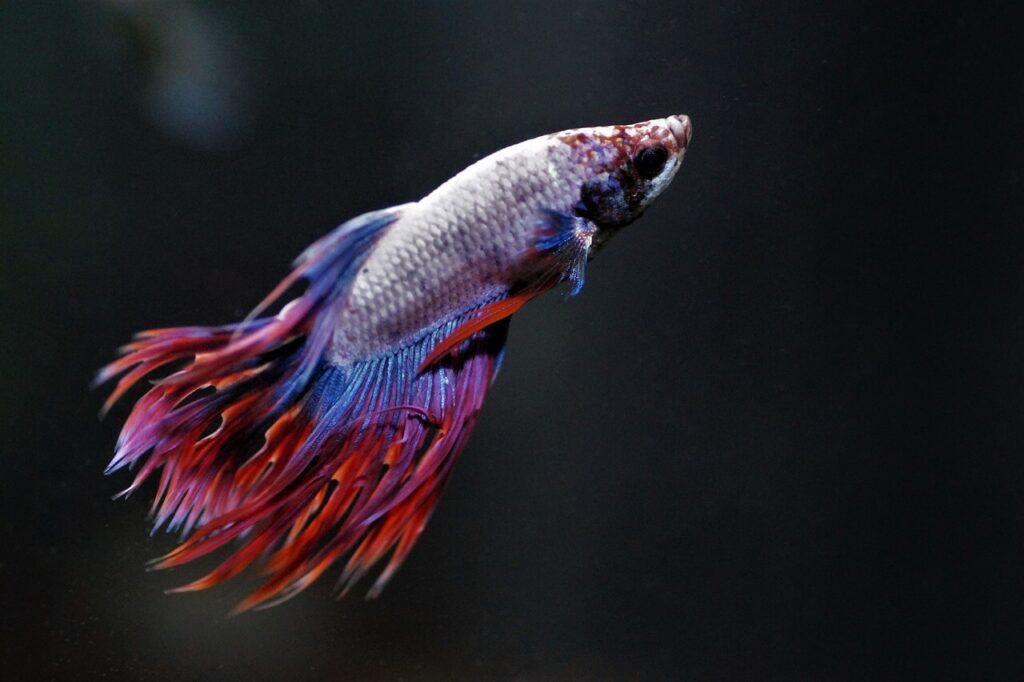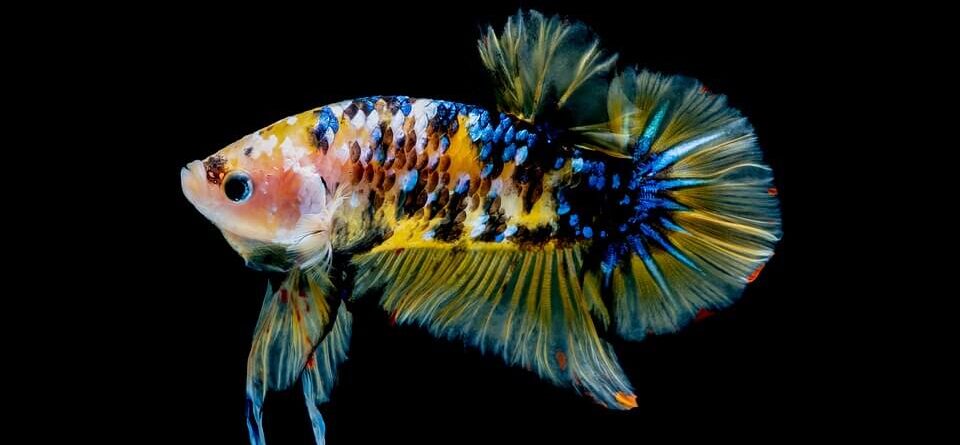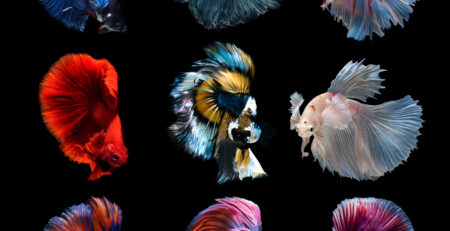Betta Fish Care : Everything You Need To Know
And to be honest, we we’re not aware of the reason. Betta fish are one of the most popular breed in the freshwater aquarium community.
You might think that there’d be a more consistent understanding of how to keep them healthy and happy.
There is a lot of false information out there about betta fish care.
Our theory is that the reason is related to the popularity, which means there’s more of a chance for differing opinions to get passed around.
But who knows what the reason might be.
Therefore we wanted to put together this betta fish care guide instantly. We get asked a lot about this fish on social media and via our contact page that it was long delayed.
In this guide you’ll be informed about everything there is to know about betta fish care, with some extra facts and information thrown in too!
Table of Contents
- Species Summary
- Size
- Appearance
- How To Care For A Betta Fish
- Water Parameters
- Temperature
- pH levels
- Water cleanliness
- Tank Size
- Additional Tank Recommendations
- What Do Betta Fish Eat?
- How Often Should You Feed Betta Fish
- Common Betta Fish Diseases & Health Issues
- Behavior & Temperament
- Betta Fish Tank Mates
- Breeding Betta Fish
- Phase 1: Courting
- Select The Bettas You Want To Breed
- Get Them Used To The Tank And Each Other
- Look For Signs Of Interest
- Let The Games Begin
- Phase 2: Fertilization
- Pass It On!
Species Summary

Betta fish (sometimes called the Siamese fighting fish) are a very common choice in the aquarium community. They’re beautiful and have a unique temperament that can be fun to observe.
A common misconception, however, is that betta fish are a low-maintenance breed. They have a specific set of needs that must be met, and if cared for accurately, can be a good choice for your tank.
Betta fish are a small fierce freshwater tropical fish native to countries in Asia and can live to be anywhere around three years old. They are found in places such as Vietnam, Cambodia, Laos, Indonesia, and Thailand (they’ve even been named Thailand’s national fish). They’re a quite adaptive fish and can regularly be found in streams, rivers and even rice paddies.
Its known that they can be trainable, they are so smart that they recognize who is caring for them. You can also teach them very simple tricks if you want!
Aside from being intelligent, they have one captivating trait they are known for – their labyrinth organ which is very similar to a lung. This means they fall into the category of “labyrinth fish” because this organ allows them to gulp air from the surface of the water.
This trait can make them immune to diseases in poor water conditions out in the wild, although you should always aim for perfect water quality in your tank at home (more on that later).
Size
Bettas have a small size, growing only up to about three inches in length. Because of their size and beauty, they’re quite a popular fish for nano tank owners.
Once they become 7 months old they’ll usually be done with their growth for the most part. However, they can sometimes grow a little bit after this time period. Your fish size is influenced by all of the usual factors:
- The quality of betta fish care you give in your tank
- The quality of care from the pet store that sold you the fish
- Genetics
When comparing female betta fish to males, fins are the biggest differentiator in. Male betta fish have longer and larger fins than females and possess a bit wider body (although the difference there is small).
Appearance
The appearance of betta fish is normally the main reason why an owner chose to buy them in the first place. They really are captivating to look at!
Bettas are extremely colorful and exist in multiple variations, but red and blue variations are the most commonly seen. Other less common colors betta fish are seen in are black, metallic variations, and multi-color.
They have fins that are large and flowing in comparison to their small bodies and are bright in color. Their colors can flash brighter if they are threatened or mating, which can be beautiful to watch.
How To Care For A Betta Fish

Like we hinted at earlier, betta fish care is something that can be more tricky than many aquarists realize. This isn’t something that should push you away if you want to get one, but you need to be aware of it.
In this section, we walk through the d areas of betta fish care that you need to get right and why they matter.
Water Parameters
The key to caring for any fish, especially bettas, is to have consistent water quality, conditions and parameters. Failing to do this can be the cause a sudden change in temperature or chemical levels, which can affect their health and immune system or even be fatal.
Temperature
The ideal water temperature for your betta fish is between 74 and 81 degrees Fahrenheit. Be careful not to place the tank by a window that’s exposed to the sun, or a heat/air-conditioning vent, as this could change the water temperature.
pH levels
The pH of the water should be between 6 and 8 –close to neutral, with a hardness between 5 and 35 dGH.
Water should be dechlorinated to safe a limit, Nitrate levels should stay below 40 ppm, and ammonia levels should be zero parts per million, and nitrite levels should be zero ppm.
As always, testing the water levels every few weeks with a test kit will make keeping your aquarium in these ranges. Tanks must be filled with tap water, or filtered water that has gone through a dechlorination process (conditioning).
Important note: never use distilled water, because it lacks important nutrients.
Water cleanliness
Your tank water must be through one complete cycle before your betta fish are added (we recommend using a water conditioner too). Having a reliable filtration system is crucial as well. About 25 percent of the water in the tank should be renewed weekly – NEVER do a 100 percent water change.
Every two weeks or so, it’s a good idea to clean the gravel/substrate, as well as the “furniture” in the tank. You can use a strainer to sift out the gravel and rinse it, as well as using an algae magnet inside the tank.
Plants and other items in the tank can be gently scrubbed and rinsed with fresh water. Do NOT use soap. At this time, half of the tank water can be dumped out and replaced with new filtered water.
Tank Size
If you want your betta fish to thrive you have to stick with the recommended tank size is essential.
Betta fish should have at least a five gallons tank. A rule of thumb is to add a gallon for every additional fish. So basically, begin with a five gallon tank and work your way up from there.
It is very common to use bowls to house betta fish, but we don’t recommend it. Bowls tend to not provide the required amount of space for these fish, which can lead to a lot of unnecessary stress.
Additional Tank Recommendations

There are a number of other various tank recommendations that you should be aware of if you want to supply excellent betta fish care.
Before we get into the list, make sure to always pay attention to whatever goes into your aquarium is labeled as “aquarium safe”. Any furniture or plants should also be cleaned with fresh water to remove debris before they are put in the betta tank.
Healthy betta fish tank has :
- A filtration system: A filter with internal modifiable power is favourable– this will enable you to ensure the water isn’t moving too rapidly for the betta’s liking.
- A heater: The most common type are completely submersible water heaters.
- Substrate: A gentle substrate of sand, pebbles etc. is perfect. One to two inches of a finely-milled substrate is favourable. This will stop your fish from scratching themselves on the bottom. It is a good idea to clean the substrate and throw away any sharp pieces before placing it in the tank.
- Plants: Plants produce a good place to retreat, as well as an enjoyable visual effect. Fake plants should be silk, so as not to damage the fish. Harsh plastic should be avoided. Live plants serve this purpose and can work on the cleanliness of the tank as well. Just make sure that access to the surface is not obstructed, because betas like to eat on the surface of the water.
- Lighting: Bettas enjoy a well-lit tank, without a harsh outside light. Too much direct sunlight can cause algal growth as well. Most tank owners prefer an LED or luminescent tank light.
It’s best to find a quiet place to put their tank, because loud noises can cause stress (which will affect their overall health).
Betta fish are not extraordinarily strong swimmers, so anything more than a light current will cause them stress as well. Due to their fascinatinability to receive air from the surface, betta fish isn’t in need of an aerator in the tank.
Lastly. It’s very important to possess a sturdy lid on an aquarium housing bettas. They usually come up to the surface and can jump out of the water quite well.
What Do Betta Fish Eat?
It’s very important that your betta fish eat properly. A well-rounded diet allows them to be more active, happier, and brighter in color.
They’re carnivores, effortlessly achieved through betta fish flakes. Though their main fish food should contain the flakes, they may also be given live food like bloodworms or brine shrimp occasionally as a snack to enjoy.
How Often Should You Feed Betta Fish
Most adult fish eat twice a day. Each fish only needs a “pinch” of flakes per meal.
Because they are so active, Betta fish tend to eat more than they actually need. This makes it very easy for them to be overfed (especially if you’re using food to help train them to do tricks).
An effective way to avoid this is by only giving them what they can eat in five minutes.
Your betta may be overfed if it showing abnormal behaviors. If this becomes the case, don’t feed it for one day.
Common Betta Fish Diseases & Health Issues
It’s important to know which behaviors are related to illness in your betta fish. Watching for these behaviors and symptoms can be essential in keeping your fish alive.
Common issues include:
- Cuts/scrapes: This can be issued by substrate or tank mates. These can become infected, so it is important to check them daily.
- Fin rot: This can be caused by bacteria in dirty water, or as a symptom of another problem. Fin rot usually starts at the fin’s edge, causing the tissue to become dull and lifeless-looking.
- Overfeeding: As mentioned above, lethargy or abnormal swimming style indicate overfeeding. This can be remedied by not feeding then for a day. Many betta fish owners “fast” their fish for a day each week to control digestive health and prevent overfeeding.
- Lymphocystis: A viral infection denoted by small, white dots that become cauliflower-like growth on the skin.
- White Spot Disease or “ich”: Often confused with Lymphocystis, this shows in white spots that look like grains of salt on the skin.
Other general bizarre behaviors to watch for include hypodynamia (decreased or halted use of muscles), fish scratching their bodies along the bottom of the tank, swelling of the abdomen, hiding excessively, decreased appetite, and holding fins against the body.
All of these diseases can also affect the quality of their sleep . When this happens, their ability to heal will be diminished.
Quick tip: Many tank owners add aquarium salt to the water to decrease stress and swelling in their fish, as well as to better fin health.
Behavior & Temperament

Betta fish are very active fish, which can make them entertaining to observe. They usually go up to the surface and are hungry often.
They are also very protective of their space, and a healthy betta fish care require you to be aware of this. You’ll have to make sure that you pair them with the proper tank mates (more on that in the section below).
This protective nature can even apply to people looking at the aquarium as well. They’ll often swim up to the glass to investigate whose looking and even flash their colors as a warning! When they are threatened, betta fish will also puff out their fins and gill covers to persuade you to not mess with them.
While we don’t consider betta fish to be as aggressive as a fish like the Jack Dempsey, they’re definitely capable of being quite mean in the right situations. This is something you need pay attention to as an owner for their sake and the sake of other fish in the tank.
Betta Fish Tank Mates
Due to the potentially aggressive behaviors of this fish, extreme care must be exercised when searching for betta fish tank mates. Some owners don’t take this option in consideration because they don’t want the hassle, and that’s acceptable too.
However, we think that it’s still important to know what betta fish tank mates go together because it will give you a much better understanding of your fish.
First off, two male betta fish can NEVER coexist in the same tank. They will have the need to be dominant , and that might result a severe injury, and most likely the death of one or both of the males.
Two female fish may live with one male. Up to five females can coexist in the same tank together, but it hard to guarantee that your fish won’t end up fighting. They can be extremely combative and lead to problems therefore must be watched for conflict if they are to share a tank.
If you own a naturally aggressive fish, then giving it space is always the right thing to do. Sometimes betta fish care is all about knowing what’s right for your individual fish, not best practices.
If you want a tank mate of a different aquatic species, there are some rules to go by when deciding on a good combination for a community tank:
- Tank mates must be aggressive, and larger enough to defend themselves if needed.
- Fish duller in color are favorable. If they possess a vibrant color or have flowing tails, the betta fish may flash their colors and feel the urge to compete.
- Tank mates must have the same water condition requirements.
- There must be enough room in the tank to avoid unnecessary conflict. Water should be added with larger tank mates.
Types of fish that have a tendency to be successful in shared tanks with bettas include large, rasboras , ghost shrimp, , catfish, tetras, gouramis or mollies.
Breeding Betta Fish
Breeding betta fish can be a fascinating and intricate process if done accurately. There are a fair amount of steps to take, but when combined they improve your chances of breeding successfully.
These steps can be excuted in two phases: courting and fertilization. The female is present in the first phase only.
Phase 1: Courting
Select The Bettas You Want To Breed
To begin, you’ll want to select a male and female to breed. The pair should be not have health issue. When deciding on which female and male to pair, most people take into account their favorite color variations.
The female should be a bit smaller than the male, and both fish should be properly “conditioned” (fed a high-protein diet leading up to the intended breeding time). The most successful breeding attempts between fish take four to twelve months of age.
Get Them Used To The Tank And Each Other
Once you chose your pair, it is time to adapt them to the breeding tank (properly cycled) and to each other. This will be their new home for a while, therefore you want them to feel comfortable.
The breeding tank should contain only three to five inches of water in it, to encourage close proximity, as well as the necessary filter and heater. The filter should be extra gentle at this point –moving water excessively will disturb the bubble nest that the male will build later.
The bottom shouldn’t contain substrate. When the eggs are laid, they could go down to the bottom and be lost in the sand/pebbles! You should also have plants in the breeding tank to give the female places to hide throughout the breeding process, as the males are able to get violent.
Most breeders put a divider in the tank to detach the female and the male while they get acclimated, that still permits them to see each other. The lighting should be dim- the pair need their privacy!
On the male’s side, he will be in need a floating area on the surface that will allow him to attach his bubble nest when the time comes. This can be anything that floats, such as Styrofoam , leaves or driftwood.
Look For Signs Of Interest
As the male betta fish develop an interest in the female, he may start to nip at the divider, and he will wear a darker in color.
If interested, the female betta fish will exhibit vertical stripes (called her “barring pattern”), and will darken to. Her ovipositer (the area she lays eggs from) will protrude more, and she will move her tail in the direction of the male.
It’s at this time that the male will build his bubble nest, making use of the surface mentioned above. The divider may be removed, but it is essential to watch for lethal conflicts.
if the male get too violent, they may need to be separated. If the female betta fish instantly destroys the bubble nest, they will also need to be separated, and the process will need to start over.
Let The Games Begin
Throughout the mating process, the pair will pursue each other around the tank, using their flashy colors. They may bite at each other as well, and the female may hide until she’s ready to submit.
When this takes place, the male will flip her upside-down and will begin to fertilize the eggs as she releases them. They will be doing this on and off for a while.
Once the female betta fish has finished the process of laying all of her eggs, she will swim away, and the male will carry the eggs to the bubble nest. The female should be removed at this time to avoid conflict and to stop her from eating any of the eggs.
Phase 2: Fertilization
The male betta fish will release a substance called milt into the water to fertilize the group of eggs (called the fry). In the next day or two, the male will maintain the nest, catching the babies when they’ve used up the oxygen in the bubble nest and start to drown.
He will repair the nest, placing the babies back until they begin to swim, after about four days. The male should be taken away at this time, the breeding process complete.
Pass It On!
Now that you have that you can understand how to take care of betta fish, you’ll be able to help your fish thrive and provide the quality of life that they deserve for them.
But don’t stop there.
As we mentioned above, there’s a lot of false information about betta fish care being passed around online. Now that you know what to do and what to avoid, share the knowledge!
Betta fish aren’t going to get irrelevant. The more we can educate owners about how to give proper care to their fish, the better off everyone will be.
Feel free to share the link to this guide on social media, or just blab about what you learned to your aquarist friends. It will help us ensure that these fish live better lives in aquariums around the world.





